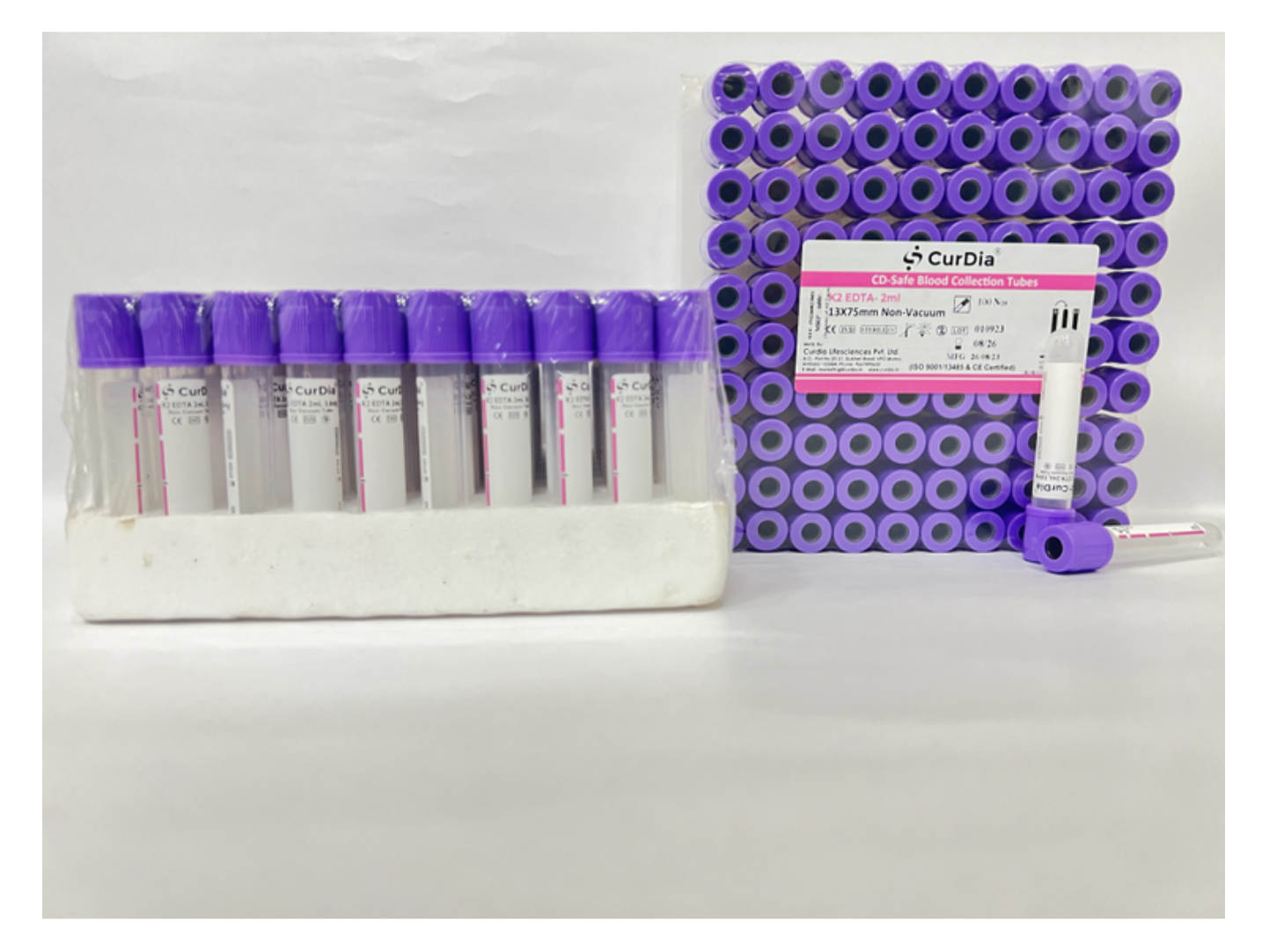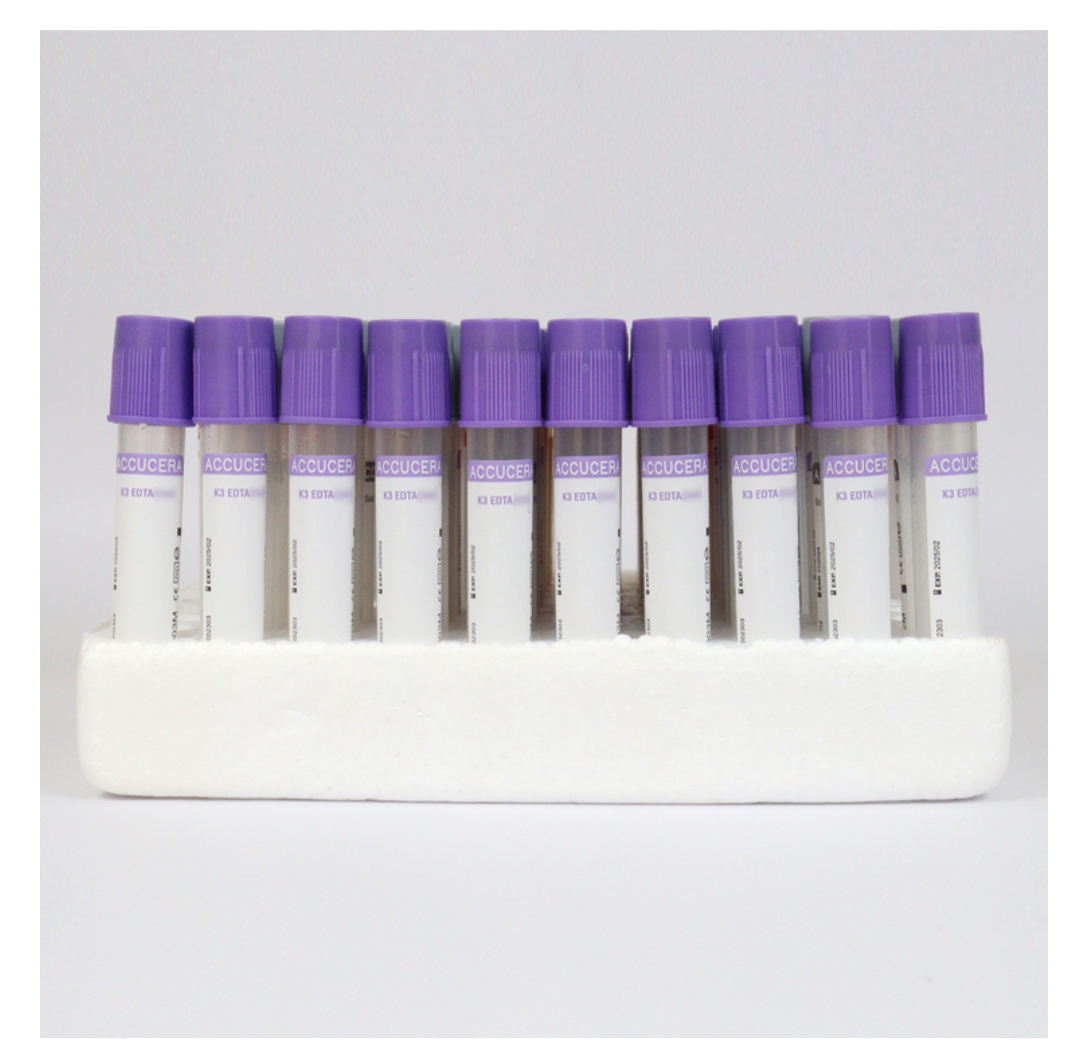EDTA Vial Uses, Tests, and Safety


What is an EDTA Vial?
EDTA tube vials contain EDTA as an anticoagulant and are commonly used in whole blood hematology tests, particularly for routine blood examinations. They provide reliable protection for blood cells, especially platelets, by preventing platelet clumping and maintaining the natural shape and volume of cells for an extended period.
These tubes are available with K2EDTA or K3EDTA for blood routine testing, and the rubber stopper is designed to be compatible with all standard analyzer probes.
EDTA Vial Uses in Clinical & Diagnostic Labs
The EDTA vial list is extensive, and they have a vital role in many medical and laboratory applications. Here are some of the most common uses:
Hematology Testing:
Widely used for tests like CBC (Complete Blood Count), EDTA tubes prevent blood cells from clumping or changing shape. This ensures accurate counts of red blood cells, white blood cells, and platelets critical for diagnosing conditions such as anemia, infections, and leukemia.
Molecular Diagnostics:
EDTA helps preserve DNA and RNA, making these tubes suitable for PCR tests, genetic screening, and other molecular studies. By protecting nucleic acids from breakdown, they ensure reliable results in advanced diagnostic testing.
Transfusion Medicine:
Pink-top EDTA tubes are used in blood typing and cross-matching. They help ensure donor and recipient blood is compatible, minimizing the risk of transfusion reactions.
Erythrocyte Sedimentation Rate (ESR):
EDTA tubes are also used for ESR tests, which measure how quickly red blood cells settle in plasma a useful indicator of inflammation in the body.
Types of EDTA Tubes & Their Colour Codes
EDTA tubes come in different colours, each serving a specific purpose in laboratory testing:
Lavender-Top Tubes: The most commonly used, ideal for Complete Blood Count (CBC) and other routine hematology tests. They keep blood cells stable, ensuring accurate results.
Pink-Top Tubes: Primarily used in blood banking for cross-matching and blood typing, helping ensure safe and compatible transfusions.
Tan-Top Tubes: Specially designed for lead testing, providing accurate results by minimizing contamination risks.
Royal Blue-Top Tubes: Used for trace element analysis such as zinc, copper, or heavy metals, where even the slightest contamination can affect the accuracy of the test.
Which Tests Use an EDTA Vial?
EDTA vials are widely used in routine and specialized tests. Common examples include:
- To measure red and white blood cells, hemoglobin, hematocrit, and platelets.
- To monitor long-term blood sugar control in diabetic patients.
- For examining the size, shape, and number of blood cells under a microscope.
- To check for signs of inflammation in the body.
- Such as PCR and DNA/RNA studies, where sample preservation is essential.
Guide to Using EDTA Tubes
EDTA tubes are among the most commonly used blood collection tubes, and using them correctly is important to ensure accurate test results. Here are some simple guidelines:
- EDTA tubes should usually be filled after serum and citrate tubes but before fluoride tubes. This helps avoid contamination from other additives.
- Always fill the tube to the marked line. Underfilling can dilute the anticoagulant-to-blood ratio, while overfilling can affect test accuracy.
- Gently invert the tube 8–10 times immediately after collection. Do not shake vigorously, as this can damage blood cells and alter results.
- EDTA samples should be processed within the recommended time frame. Delays can cause cell morphology changes that affect hematology tests.
- Make sure the blood mixes well with EDTA, as incomplete mixing can lead to clot formation and unusable samples.
- Use the correct EDTA tube (lavender, pink, tan, or royal blue) depending on the specific test being performed.
Common Errors in EDTA Tube Usage & How to Avoid Them
Using EDTA tubes correctly is essential for accurate test results. Here are some common mistakes and tips to prevent them:
Not drawing enough blood can alter the ratio of anticoagulant to blood, leading to inaccurate results. Always fill the tube to the marked line.
Vigorous shaking can damage blood cells. Gently invert the tube 8–10 times instead of shaking.
Waiting too long before inverting the tube can cause clots to form. Mix immediately after collection.
Leaving samples for too long before testing may affect cell shape and counts. Process samples within the recommended time frame.
Different coloured EDTA tubes serve different tests. Double-check the colour code before collection.
Related Products

3.9
Fastest by 9th Jan
COD
Curdia K2EDTA Non Vacuum Blood Collection Tube
₹174
₹162 with MBFIRST

4.5
Fastest by 20th Jan
COD
Levram K3EDTA Non Vacuum Blood Collection Tube
₹195
₹182 with MBFIRST

Fastest by 17th Jan
COD
BDK Life Sciences K3 EDTA Blood Collection Tube Vacuum
₹273
₹252 with TUBE8

Fastest by 17th Jan
COD
BDK Life Sciences Gel Clot EDTA Blood Collection Tube Vacuum
₹431
₹397 with TUBE8

Fastest by 20th Jan
COD
Strion K2 EDTA Vacuum Blood Collection Tube
₹273
₹254 with MBFIRST

FAQs









